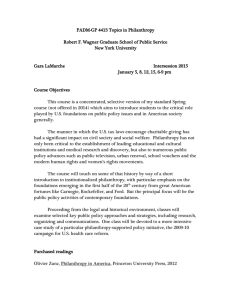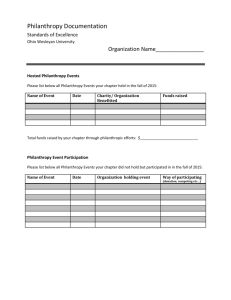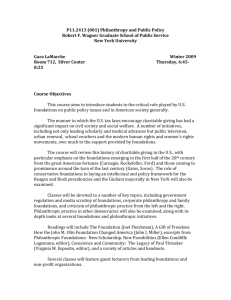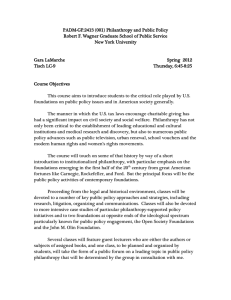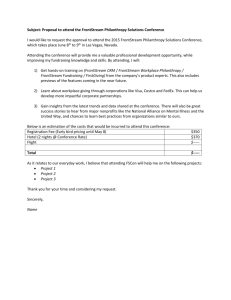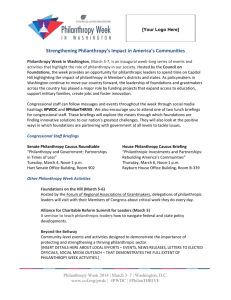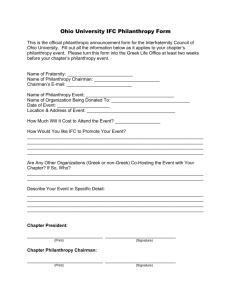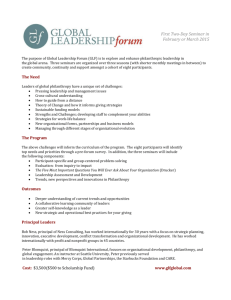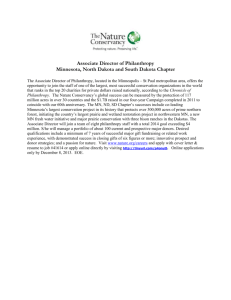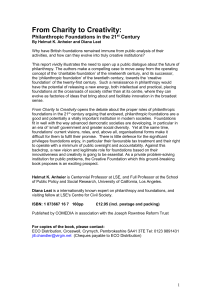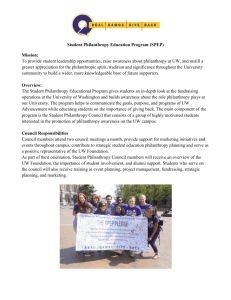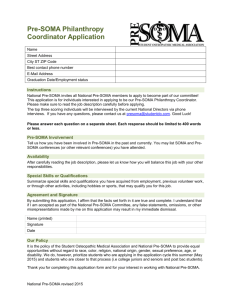P11 - NYU Wagner - New York University
advertisement
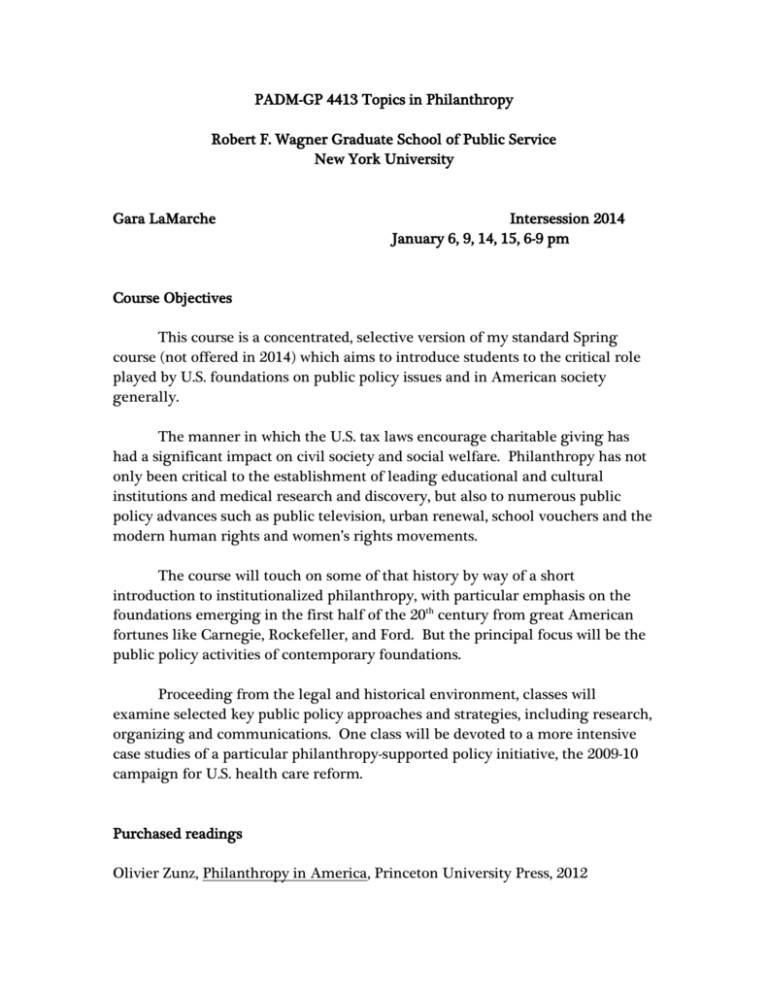
PADM-GP 4413 Topics in Philanthropy Robert F. Wagner Graduate School of Public Service New York University Gara LaMarche Intersession 2014 January 6, 9, 14, 15, 6-9 pm Course Objectives This course is a concentrated, selective version of my standard Spring course (not offered in 2014) which aims to introduce students to the critical role played by U.S. foundations on public policy issues and in American society generally. The manner in which the U.S. tax laws encourage charitable giving has had a significant impact on civil society and social welfare. Philanthropy has not only been critical to the establishment of leading educational and cultural institutions and medical research and discovery, but also to numerous public policy advances such as public television, urban renewal, school vouchers and the modern human rights and women’s rights movements. The course will touch on some of that history by way of a short introduction to institutionalized philanthropy, with particular emphasis on the foundations emerging in the first half of the 20th century from great American fortunes like Carnegie, Rockefeller, and Ford. But the principal focus will be the public policy activities of contemporary foundations. Proceeding from the legal and historical environment, classes will examine selected key public policy approaches and strategies, including research, organizing and communications. One class will be devoted to a more intensive case studies of a particular philanthropy-supported policy initiative, the 2009-10 campaign for U.S. health care reform. Purchased readings Olivier Zunz, Philanthropy in America, Princeton University Press, 2012 Course requirements and grading All students are required to: 1. Complete readings in advance of class sessions. 2. Attend class regularly and participate in discussions. 3. Write one ten page essay, focusing on one of four topics to be distributed by the instructor at the first session and due two weeks after the final session. Course Schedule and Readings Note: Assigned readings follow session description in this small font. URLs provided for most; for the balance, handouts will be given out at the first class. Optional readings are marked with an asterisk. I. January 6: Introduction and Overview. Legal and regulatory framework. Historical Antecedents, from the Progressive Era to the 1960’s. Why some foundations support public policy initiatives – and why they don’t. Come prepared to talk about yourself and your expectations of the class, and I will do the same. I’ll provide an overview of what the class will cover, and we’ll explore why support of public policy advocacy is viewed by many foundations as a critical tool for advancing their mission, as well as why many foundations are skittish about it. We’ll also discuss the great fortunes, including Carnegie and Rockefeller, and the template set by the foundations they spawned one hundred years ago; the Russell Sage, New York, Rosenwald and Ford Foundations; the support provided by foundations such as Field and Taconic for the social movements of the 1950s and ‘60s. Philanthropy in America, Zunz, Chapters 1, 3 and 6. The Cost of Caution: Advocacy, Public Policy and America’s Foundations, National Press Club Forum, April 21, 2005 http://www.dev.ncrp.org/files/ar-042105- centerforpublicandnonprofitleadership-the_cost_of_caution.pdf Words to Give By: Leading Voices in Advocacy Funding, Alliance for Justice, http://bolderadvocacy.org/wp-content/uploads/2012/01/Words_to_Give_By.pdf* “Taking Risks That Matter”, Centennial Publication of The New York Foundation, 2007, http://nyf.issuelab.org/resource/celebrating_100_years_taking_risks_that_matter* Carnegie Reporter, Special Centennial Edition, Part 2, Spring 2011, http://carnegie.org/publications/carnegie-reporter/single/view/issue/item/387/ “Rosenwald’s Shadow?”, Stephanie Deutsch, Philanthropy, Fall 2011, http://www.philanthropyroundtable.org/topic/donor_intent/rosenwalds_shadow Remarks of David R. Hunter, North Star Dinner, September 24, 1984, and at 26 th Annual Conference, Council on Foundations, April 22, 1975 (handout)* “Field Foundation, Civil Rights Pioneer, to Die at 49; Survivors Will be Legion,” Kathleen Teltsch, The New York Times, February 19, 1989, http://www.nytimes.com/1989/02/19/us/field-foundation-civil-rights-pioneer-to-die-at-49survivors-will-be-legion.html?pagewanted=all “Richard Boone and the Field Foundation: Beacons of Leadership for Social Justice Philanthropy,” Gara LaMarche, Atlantic Currents, April 13, 2009, http://www.atlanticphilanthropies.org/currents/richard-boone-and-field-foundationbeacons-leadership-social-justice-philanthropy II. January 9: Strategies for public policy change: research, policy, communications campaigns, litigation, organizing, movementbuilding How foundation support for research and policy analysis builds a case for action; how investments in communications campaigns (including public opinion research and framing) builds on that. Likely to cover federal budget battles of the last thirty years and criminal justice campaign on drug policy, incarceration and the death penalty. How litigation can dovetail with community organizing and other strategies to advance policy change in certain fields. Why some funders are investing more in organizing and movement-building. Likely to focus on several younger organizations, like The Advancement Project and Make the Road New York, that combine litigation and organizing strategies. Zunz, Chapters 7 and 8 Spitfire Communications Toolkits: Smart Chart 3.0, Discovering the Activation Point, Just Enough Planning Guide, http://www.spitfirestrategies.com/spitfire-tools.html “Social Movements and Philanthropy: How Foundations Can Support Movement Building,” Barbara Masters and Torie Osborn, The Foundation Review, http://evaluationinnovation.org/sites/default/files/Masters%20Movement%20Building%20. pdf “Why Movements Matter,” Vivien Labaton and Gara LaMarche, The American Prospect, May 11, 2011, http://prospect.org/article/why-movements-matter “A Strategic Evaluation of Public Interest Litigation in South Africa,” Atlantic Philanthropies, 2009, http://www.atlanticphilanthropies.org/learning/evaluation-publicinterest-litigation-south-africa-offers-lessons-advocates* “Leveraging Limited Dollars: How Grantmakers Achieve Tangible Results by Funding Policy and Community Engagement,” National Committee for Responsive Philanthropy, January 2012, http://www.ncrp.org/files/publications/LeveragingLimitedDollars.pdf III. January 14: Case study: The Atlantic Philanthropies and health care reform The Affordable Care Act of 2010 was by most accounts the most significant piece of social welfare legislation since Lyndon Johnson’s great society programs like Medicare and Medicaid. We will examine the role that foundations played in the lead-up to the legislation, the battle over it, and the aftermath, with particular attention to the Atlantic Philanthropies, which made a grant to $26.5 million to Health Care for America Now, at the time the largest advocacy grant ever made by a foundation. Excerpts from Remedy and Reaction: The Peculiar American Struggle Over Health Care Reform, Paul Starr, Yale University Press, 2011, and Fighting for Our Health, Richard Kirsch, The Rockefeller Institute Press, 2012 (to be distributed) “The Key Role of Advocacy Funding in the U.S. Health Care Reform Debate,” Gara LaMarche, Grantmakers in Health Conference, Orlando, Florida, March 11, 2010, http://www.atlanticphilanthropies.org/learning/speech-key-role-advocacy-funding-ushealth-reform-debate-gara-lamarche HCAN Evaluation: Executive Summary, prepared for the Atlantic Philanthropies by Grassroots Solutions, 2010, http://www.atlanticphilanthropies.org/learning/evaluationexecutive-summary-findings-and-lessons-hcan-campaign IV. January 15: Emerging critiques of foundation policy initiatives With greater foundation engagement in policy comes greater scrutiny and criticism: of the Gates Foundation as so big and opinionated that it dominates the fields of education reform and public health and drowns out other voices and approaches; of many “mainstream” funders for being too timid; of “venture philanthropists” for adopting business practices ill-suited to the non-profit world and insisting on crude metrics that don’t capture the nuances of how change takes place. We’ll survey these critiques and examine a few of them in detail. “The Gated Community,” Edward Skloot, Alliance Magazine, September 2011, http://www.alliancemagazine.org/node/3834 “Metrics Mania: The Growing Corporatization of U.S. Philanthropy,” Alison R. Bernstein, Thought and Action, Fall 2011, http://www.nea.org/home/50022.htm* “Why Do Progressive Foundations Give Too Little to Too Many?,” Michael H. Shuman, The Nation, January 12/19 1998, http://www.thenation.com/archive/why-do-progressivefoundations-give-too-little-too-many* “Got Dough? Public School Reform in the Age of Venture Philanthropy,” Joanne Barkan, Dissent Magazine, Winter 2011, http://www.dissentmagazine.org/article/?article=3781 Transcript of “Living With the Gates Foundation,” Hudson Institute, December 6, 2011, http://www.hudson.org/index.cfm?fuseaction=hudson_upcoming_events&id=899* “Should Philanthropies Operate Like Businesses?” Wall Street Journal, December 15, 2011, http://online.wsj.com/article/SB10001424052970204554204577024313200627678.html “What Does It Mean to Say that Philanthropy is ‘Effective’? The Philanthropists’ New Clothes, Stanley N. Katz, American Philosophical Annual Meeting, April 23, 2004, http://www.amphilsoc.org/sites/default/files/490201.pdf* Conversation with Jeff Raikes, CEO of the Gates Foundation, Philanthropy New York, May 12, 2011, http://fora.tv/2011/05/12/A_Conversation_with_Jeff_Raikes_and_Gara_LaMarche* Note: Most of my speeches and writings on philanthropic topics, including the ones recommended in the syllabus, can be found at: http://www.atlanticphilanthropies.org/news/news?filter=speeches or on my personal blog, http://www.garala.typepad.com/ http://www.youtube.com/playlist?list=PLEkPQai2-5psKL72JpKi4bqEAR7t00A96&feature=plcp
